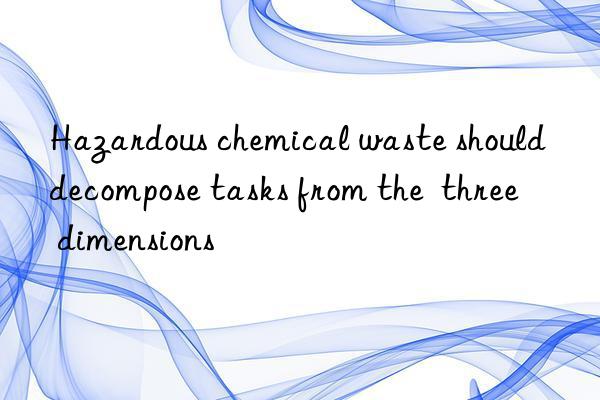
On July 27, at the 5th Symposium on Source Reduction and Resource Utilization of Hazardous Chemical Wastes held in Wuxi, participating experts proposed that the management of hazardous chemical wastes should start from the "three modernizations", that is, reduction, resource utilization, Harmless Dimension Decomposition Task. At the same time, under the requirement of "low carbonization", the treatment of chemical hazardous waste should establish a new concept of "three modernizations +".
The chemical industry is a key area for the generation and disposal of hazardous waste. National environmental protection laws and regulations are becoming stricter, and action plans have been issued one after another. Li Xiaoping, deputy secretary-general of the China Industrial Environmental Protection Promotion Association, believes that hazardous waste in the chemical industry is facing the challenge of superimposed stock and increase. Source reduction and resource utilization.
Zheng Yang, Director of the Hazardous Waste Management Technology Department of the Solid Waste Center of the Ministry of Ecology and Environment, proposed that the main tasks in the field of hazardous waste should be broken down from the dimensions of reduction, recycling, and harmless, that is, "three modernizations". In terms of volume reduction, it is necessary to develop and promote production techniques and equipment that reduce the generation of industrial hazardous waste and reduce the hazards of industrial hazardous waste, and accelerate the issuance of pollutant discharge permits for industrial solid waste and hazardous waste treatment units in the region; On the one hand, implement "point-to-point" directional utilization exemption management; on the harmless aspect, it is necessary to promote large-scale development and professional operation, improve the basic guarantee capacity of centralized disposal, and establish a regional joint prevention and control mechanism for environmental risks of hazardous waste, and implement ecological environment damage. Compensation system, full implementation of environmental pollution liability insurance, etc.
Zheng Yang emphasized that under the goal of "double carbon", "low carbonization" requires that the environmental management of solid waste should establish a new concept of "three modernizations +", that is, "reduction + low carbonization", and coordinate solid waste at the source of generation Reduction and reduction of greenhouse gas emissions; "recycling + low-carbonization", that is, replacing solid waste with materials, energy, and product recycling to exert its indirect carbon emission reduction benefits; "harmless + low-carbonization", that is, through energy Substitution and technological innovation to achieve low-carbon development of solid waste utilization and disposal.
Li Wenfeng, chief engineer of Shandong Provincial Academy of Environmental Sciences Environmental Testing Co., Ltd. believes that resource utilization is the development direction of the industry. On the premise that environmental risks are controllable, "point-to-point" directional utilization of hazardous waste can be implemented. He said that Zhejiang, Shandong, Guangdong, Sichuan, Hebei and other provinces have successively introduced "zero waste city" plans, all expressing their efforts to promote the utilization of solid waste resources. For example, the pilot program of Zhejiang Province proposes to deepen the "point-to-point" utilization pilot of hazardous waste in key areas and key industries, explore the construction of a centralized activated carbon regeneration center, improve the comprehensive and coordinated management of various pollutants, and expand the resource utilization channels of industrial hazardous waste; Jiangsu Province The pilot plan proposes to guide the use of solid waste, reduce the amount of landfill, and realize the reduction of the whole process of solid waste disposal industry on the basis of reduction, recycling, and harmlessness. Closed circulation of materials within the park, among enterprises and between industries, solid waste recycling...
"Shenzhen, as a national pilot project for the construction of a 'waste-free city', uses the solid waste smart supervision system to realize the unified supervision of all types of solid waste. Billing, video monitoring, GPS tracking and other technologies to realize the whole-process coverage and supervision of solid waste production, transportation, and disposal; realize intelligent early warning for scenarios such as overdue storage of solid waste, insufficient disposal capacity, and illegal dumping; Dimensional mining and analysis provide data support for the planning of "Zero Waste City". Work efficiency." Liu Jingyang, deputy director of the Cleaner Production and Circular Economy Research Center of the Chinese Academy of Environmental Sciences, said.
Enterprise representatives also shared technical cases of chemical hazardous waste treatment. Cai Qiannan, assistant to the general manager of Hangzhou Dongri Energy Saving Technology Co., Ltd., introduced how to completely solve the environmental protection problem of waste acid, realize the reuse of resources, and achieve the effect of "no waste"; Dr. Song Chen from Nanjing Letosi Environmental Biotechnology Joint Research Center introduced the source With the sludge reduction BARMS process, the reduction of exported sludge can reach more than 50%. (Peng Yan)



 微信扫一扫打赏
微信扫一扫打赏
